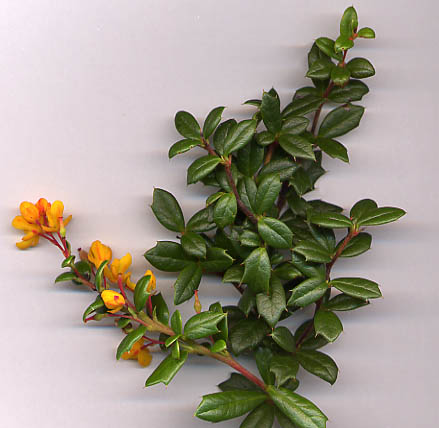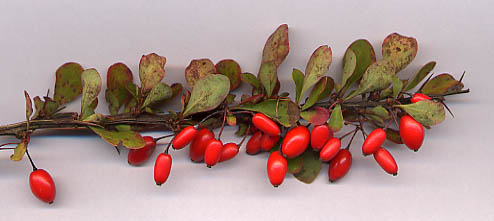- Berberis
Taxobox
name = "Berberis"

image_width = 240px
image_caption = "Berberis darwinii" shoot with flowers

image2_width = 240px
image2_caption = "Berberis thunbergii" shoot with fruit
regnum =Plant ae
divisio = Magnoliophyta
classis =Magnoliopsida
ordo =Ranunculales
familia =Berberidaceae
genus = "Berberis"
genus_authority = L.
subdivision_ranks = Species
subdivision = About 450-500; see text"Berberis" ("Bér-be-ris", barberry, pepperidge bush) a
genus of about 450-500 species ofdeciduous andevergreen shrub s from 1-5 m tall with thorny shoots, native to the temperate and subtropical regions ofEurope ,Asia ,Africa ,North America andSouth America . They are closely related to the genus "Mahonia ", which is included within "Berberis" by somebotanist s.The plant
The genus is characterised by dimorphic shoots, with long shoots which form the structure of the plant, and short shoots only 1-2 mm long. The leaves on long shoots are non-photosynthetic, developed into three-spined thorns 3-30 mm long; the bud in the axil of each thorn-leaf then develops a short shoot with several normal, photosynthetic leaves. These leaves are 1-10 cm long, simple, and either entire, or with spiny margins. Only on young seedlings do leaves develop on the long shoots, with the adult foliage style developing after the young plant is 1-2 years old.
The deciduous species (e.g. "Berberis thunbergii, B. vulgaris") are noted for good autumn colour, the leaves turning pink or red before falling. In some evergreen species from
China (e.g. "B. candidula, B. verruculosa"), the leaves are brilliant white beneath, making them particularly attractive.The
flower s are produced singly or inraceme s of up to 20 on a single flower-head. They are yellow or orange, 3-6 mm long, with sixsepal s and sixpetal s in alternating whorls of three, the sepals usually coloured like the petals. Thefruit is a smallberry 5-15 mm long, ripening red or dark blue, often with a pink or violet waxy surface bloom; they may be either long and narrow (like a bar, hence 'barberry') or in other species, spherical."Berberis" species are used as food plants by the
larva e of someLepidoptera species includingMottled Pug .Several are popular
garden shrubs, grown for their ornamental leaves, yellow flowers, and red or blue-black berries. They are also valued for crime prevention; being very dense, viciously spiny shrubs, they make very effective barriers impenetrable to burglars. For this reason they are often planted below potentially vulnerable windows, and used as hedges and other barriers.Historically, yellow dye was extracted from the stem, root, and bark. [cite book|author=Tomlinson, C., ed.|title=
Tomlinson's Cyclopaedia of Useful Arts |year=1866|publisher=Virtue & Co.|location=London Vol I, page 97.]"Berberis vulgaris" (European barberry) is the alternate host species of the wheat rust "Puccinia graminis", a serious fungal
disease ofwheat . For this reason, cultivation of this species is prohibited in many areas.Some "Berberis" have become
invasive species when planted outside of their native ranges, including "B. glaucocarpa" and "B. darwinii" inNew Zealand (where it is now banned from sale and propagation), and "B. thunbergii" in some parts of North America.Culinary uses
The berries are edible, and rich in
vitamin C , though with a very sharp flavour; the thorny shrubs make harvesting them difficult, so in most places they are not widely consumed. They are an important food for many smallbird s, which disperse theseed s in their droppings."Berberis" is often used in
borsch as a spice. Throughout the formerSoviet Union , they are also used as the flavouring in a popular candy of the same name. In Kazakhstan the dried fruits are used to add flavour to a traditional dish Plov (lamb with rice)."Berberis buxifolia" (Calafate) and "Berberis darwinii" (Michay) are two species found in
Patagonia inArgentina andChile . Their edible purple fruits are used for jams and infusions; anyone who tries a berry is said to be certain to return to Patagonia. The calafate and michay are symbols of Patagonia.Zereshk
"Zereshk" () is the Kurdish and Persian name for the dried
fruit of "Berberis vulgaris ", which are widely cultivated inIran . Iran is the largest producer of "zereshk" andsaffron in the world. "Zereshk" and saffron are produced on the same land and theharvest is at the same time. TheSouth Khorasan province inIran is the main area of "zereshk" production. A garden of "zereshk" is called "zereshk-estan".Zereshk is widely used in cooking, imparting a tart flavor to chicken dishes. It is usually cooked with
rice , called "zereshk polo", and provides a nice meal with chicken. "Zereshk" jam [http://www.niavaran.ir/ja.barberry%20jam.jpgphoto] , "zereshk" juice [http://www.flickr.com/photos/marsopolitan/16945788/ photo] , and "zereshk" fruit rolls [http://sadaf.com/store/media/56-6807.jpgphoto] are also produced in Iran.In colloquial Persian, "zereshk" is used as a term for showing dissent or disagreement, similar to the usage of "
blowing a raspberry " in English. Although not a vulgar term in that context, it is not used in polite speech.fact|date= April 2008elected species
Gallery
References
* cite web
last =Murrills
first =Angela
authorlink =
coauthors =
title =Best Eating: Check, please
work =
publisher =Straight.com
date =2005-11-24
url =http://www.straight.com/node/10692
format =
doi =
accessdate =2007-05-02* cite web
last =Wilkinson
first =Bobbie
authorlink =
coauthors =Tom Wilkinson
title =It's an Adventure in Persian Cuisine at Darya Kabob
work =
publisher =The Washington Post
date=2004-08-15
url =http://www.washingtonpost.com/ac2/wp-dyn/A64091-2004Aug13?language=printer
format =
doi =
accessdate =2007-05-02* cite web
last =Arellano
first =Gustavo
authorlink =
coauthors =
title =Naan & Kabob
work =
publisher =Orange County Weekly
date =2004-03-18
url =http://www.ocweekly.com/columns/this-hole-in-the-wall-life/naan-kabob/15514/
format =
doi =
accessdate =2007-05-02
* [http://www.rnzih.org.nz/pages/berberisglaucocarpa.htm Royal New Zealand Institute of horticulture. "Berberis glaucocarpa"]External links
* [http://lakecounty.typepad.com/life_in_lake_county/2007/05/berberine_thoug.html Berberine Thoughts] – Informative but non-scholarly essay on barberry and "Berberis" (culture, history and etymology)
ee also
*
Berberine Zereshk
* [http://waynesword.palomar.edu/images/berber2b.jpgPicture of packaged "Berberis" fruit] (
Zereshk ) as sold in Iran and in the US.
Wikimedia Foundation. 2010.
